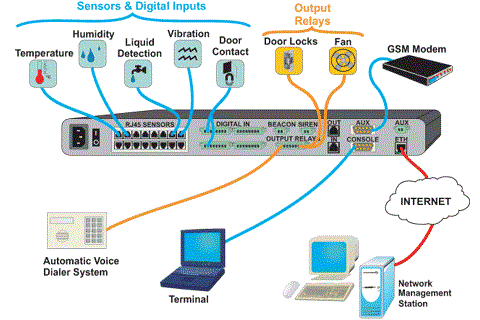Protect your Data Center
Protecting your data center from environmental threats
Data center / Server Room serves a critical function in an organization as it controls the flow of data as well as the storage of such data for future use. A data center runs on a 24 hour, 7 day and 52 week basis so it is always supported with sufficient air conditioning system and uninterruptible power supplies. Due to its non-stop nature, a data center, requires the highest level of monitoring and data protection from malfunctions caused from damage to the Network Infrastructures.
The most common environmental threats to server rooms are temperature, humidity, water leaks, human error, intrusion, vibration, and power outage. Many of these threats, such as temperature and humidity, are related, which complicates environment monitoring and heightens the need for an automated, sophisticated system.

These threats can damage equipment, slow performance, and force hardware to shutdown. The costs of environmental threats are:
- Replacement of damaged items
- Lower worker productivity due to downtime
- Lost revenues from unavailable server-based applications, such as e-commerce sites or customer service centers
- Additional administrative time and money to investigate and fix problems
A environment monitoring system helps prevent the damages caused by environmental threats by monitoring critical conditions (such as temperature, humidity, and water leakage) that could destroy network components in a server room. It uses sensors to track environmental conditions around servers, workstations or data centers. When the system detects an abnormality, such as a temperature increase over the recommended limit, it sends an alert. Alerts can be flashing lights, buzzers, and messages via SNMP traps, email, SMS over GSM network and the system’s Web-based administrative interface. After IT administrators receive the alert, they can investigate and resolve the issue. Many systems log environmental data, which administrators can use to investigate problems.
Available Sensors
Temperature

An optimal environmental monitoring strategy includes multiple temperature sensors. These should be placed on top, middle, and bottom of individual racks to measure the heat being generated by equipment, and at the air conditioning system’s intake and discharge vents, to measure efficiency. Probes should also be placed around critical devices, because the temperature inside a rack-mounted device could be as much as 20 degrees higher than the surrounding area. A probe near the room’s thermostat can help monitor what the thermostat is ‘seeing’ as it controls the air conditioner.
Humidity

High humidity may lead to corrosion on electronic components and low humidity levels may cause issues with static electricity.
Airflow

Make sure air is flowing through the racks in addition to monitoring A/C vent intake and outtakes.
Water

Moisture and humidity sensors should monitor for leaks inside cooling equipment, potential leaks that come from nearby pipes, or water caused by a flood or disaster. Water sensors should be placed at the lowest point (wherever water would tend to puddle) on the floor, and underneath any pipe junctions. Air-conditioning condensation trays should also be equipped with sensors to detect overflow.
Voltage

Voltage sensors detect presence or the absence of line voltage. Identify the frequency of brown outs for measuring uninterruptable power supplies and service provider performance.
Power

Electrical failures can cause air-conditioning equipment to shut down even while an uninterruptible power supply (UPS) ensures that servers stay up and running a sure recipe for overheating a server room in short order. The best approach is to monitor current coming into the data center, and arrange for an orderly shutdown of IT equiment in case power is knocked out. The hour or two of downtime is far preferable to the widespread device failures that would result from an overheating condition.
Smoke

Smoke alarms can trigger power shutdowns. Also, they’re usually not tied to an alerting system that contacts IT personnel. Alarms may be noticed by facilities managers—or the local fire department—but the maintenance of sensitive server equipment is not their top priority. Here, the best approach is to wire the smoke alarms directly into the climate monitoring and alerting system, essentially extending the functionality of the climate sensors to the smoke alarm.
Doors

Dry-contact sensors that detect the opening and closing of a door should be installed at the room entry points and on the doors of server and UPS cabinets. On a busy day, these sensors can send alerts numerous times and present a time-consuming irritation, but managers can configure alerts to account for weekday vs. weekend operations, work hours vs. overnights, and other factors to help reduce the number of alerts sent and pinpoint unusual activities.
CCTV

Real-time surveillance of sensitive areas in the data center and tie into the Web-based console, so administrators can get a first-hand look at the environment wherever they may be.
